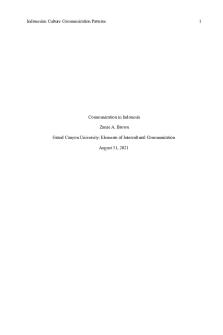Culture Jamming PDF

| Title | Culture Jamming |
|---|---|
| Author | Alex van Eeden |
| Course | Media & Society |
| Institution | University of Cape Town |
| Pages | 3 |
| File Size | 140.9 KB |
| File Type | |
| Total Downloads | 93 |
| Total Views | 145 |
Summary
Exam notes...
Description
Culture Jamming What is culture jamming? A form of media activism that subverts and reworks the intended meaning of existing media texts, or parodies major corporations, public figures, and their media images. “the practice of parodying advertisements and hijacking billboards in order to drastically alter their messages. Streets are public spaces, adbusters argue, and since most residents can’t afford to counter corporate messages by purchasing their own ads, they should have the right to talk back to images they never asked to see” – Klein Media activism – activities involving individuals or lobby groups that attempt to change the way in which the media works, or that use the media to make a social or political statement Adbusting – modifying advertisements to undermine their intended meaning What’s at stake? Citizens versus corporations. Who actually has right of access to the public sphere? Do private interests overshadow public interests? Do corporations have too much power? o Access to public space. o Access to young and impressionable minds. o Pushing ethical boundaries. o Poor labour practices. How does it work? Parody – double process of inscription and subversion Invokes the viewer’s knowledge of the brand being invoked, and subverts the meaning of the ad.
Parody as social comment: The font style and colours are trademarks of Coca Cola. The substitution of “Enjoy Capitalism” for “Enjoy Coca Cola” invites one to think about a seemingly innocuous and common commodity as being part of an invasive economic system. Semiotically: The fonts and colours are signifiers of the brand, Coca Cola, and all that the brand has come to embody (signifiers), as a result of years of marketing. The sign is “hijacked”; the intended signifieds are displaced so that new signifieds are attached to the signifiers of the original sign. The new meanings are in dialogue with the original meanings. important to look at – images on slides At odds with hegemony: Global corporations extend market share by spending less on production and salaries in order to spend more on marketing and branding. This is where culture jammers wage their war: by jamming communication strategies that are geared towards earning consent. Culture jammers draw our attention to the production of messages; processes through which dominant ideologies win our consent through their dominance. They draw our attention to the process of production of commodities; what lies behind the brand. Hegemony and our agency: Hegemony is not given and permanent. It has to be actively struggled for and won. “Winning consent and legitimacy is in a ‘constant process of formation’, a succession of ‘unstable equilibria’ between the interests of the dominant and subordinate groups where the dominant group interests tend to prevail ‘but only to a certain point’”. Laugh It Off: “Carling Black Label Beer. America’s lusty, lively beer brewed in South Africa.” “Black Labour White Guilt. Africa’s lusty, lively exploitation since 1652. No regard given worldwide.” Comment on colonial past; ironies of SAB marketing strategy: targets “uneducated black mass market”. “By targeting this market, and associating themselves so closely with this black working class in their marketing campaigns ... Black Label must accept the consequences of their association. We believe that in a democratic arena, someone making a comment about, and on behalf of, the working class is perfectly justified in using a symbol that has been heavily associated with them.” – Nurse Brands and the public: Intellectual property has a cultural life. Once brands and marketing messages enter the public domain they become part of citizens’ lives. How far can corporations go in telling people what they can do with this property? Public property?
Should we think of brands as public property? Is it true that if you grew up drinking Coke, that this brand is a part of your life? Are you entitled to use the brand in any way you please? Do you have a moral and legal right to it?
Limitations of culture jamming: It works within the system, so it can reinforce the brand. Controversy could make the brand or corporation more desired. Trademark infringement, copyright violation, defamation: lawsuits are very expensive. Trivialise issue. Is the sale of culture-jammed merchandise hypocrisy?...
Similar Free PDFs

Culture Jamming
- 3 Pages

Culture
- 2 Pages

Jock Culture
- 6 Pages

Virtual Culture
- 3 Pages

La culture
- 9 Pages

DAMAGED CULTURE
- 1 Pages

Indonesian culture
- 6 Pages

Ob culture
- 8 Pages

Culture notes
- 4 Pages

Cop Culture
- 4 Pages

Culture notes
- 23 Pages

Culture & Ideology
- 2 Pages
Popular Institutions
- Tinajero National High School - Annex
- Politeknik Caltex Riau
- Yokohama City University
- SGT University
- University of Al-Qadisiyah
- Divine Word College of Vigan
- Techniek College Rotterdam
- Universidade de Santiago
- Universiti Teknologi MARA Cawangan Johor Kampus Pasir Gudang
- Poltekkes Kemenkes Yogyakarta
- Baguio City National High School
- Colegio san marcos
- preparatoria uno
- Centro de Bachillerato Tecnológico Industrial y de Servicios No. 107
- Dalian Maritime University
- Quang Trung Secondary School
- Colegio Tecnológico en Informática
- Corporación Regional de Educación Superior
- Grupo CEDVA
- Dar Al Uloom University
- Centro de Estudios Preuniversitarios de la Universidad Nacional de Ingeniería
- 上智大学
- Aakash International School, Nuna Majara
- San Felipe Neri Catholic School
- Kang Chiao International School - New Taipei City
- Misamis Occidental National High School
- Institución Educativa Escuela Normal Juan Ladrilleros
- Kolehiyo ng Pantukan
- Batanes State College
- Instituto Continental
- Sekolah Menengah Kejuruan Kesehatan Kaltara (Tarakan)
- Colegio de La Inmaculada Concepcion - Cebu



